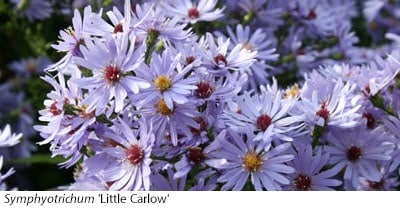Sun loving perennials
The trick is to select the very best plants, because most of us haven’t got space for the also rans or frankly the poor. We want the crème de la crème, the plants that not only look lovely but perform for a long time. We want them to return year after year and be good neighbours, ones that won’t muscle in on other things. With this in mind, it always helps to look for an AGM award, as this is a reliable indicator of a great plant.
Learn to love colour when choosing plants, because the days of the pastel English country garden that looks like a watercolour painting have largely gone. Also, try to avoid planting only one of each thing as this will resemble a pincushion of dots. Far better to plant in threes, fives or sevens, always odd numbers, and avoid forming cloud-like blobs. Make a triangular shape, or a narrow ribbon that looks like its waving in the wind. This is much more pleasing on the eye.
Day's Eyes - for open sun

The insect friendly daisy with their long-lasting ray florets surrounding a hub of tiny flowers. Staple daisies include the September-flowering lavender-blue aster now named Symphyotrichum 'Little Carlow'. It’s replaced aster, which was easier to spell, although that never bothers a botanist! This is a metre-high bushy aster that’s usually self-supporting and it has small lavender-blue flowers with a hint of red in the middle. In September light it glows like a Bunsen burner and should be planted in every garden. I particularly love the glint of red in the intricately-feathered buds in August.
 Anthemis ‘E.C. Buxton’ is a golden oldie that’s been around for decades, but it can’t be beaten for flower power because this summer performer produces clear yellow daisies on strong green stems above dark green filigree foliage. The flowers last for weeks, a trait with daisies, and this sun-lover can be drifted through with deep blue eryngiums such as Eryngium × zabelii 'Jos Eijking' or used with rusty achilleas such as Achillea 'Walther Funcke'. All three will come through winter reliably well, although anthemis need regular propagation every two years or so. Just pluck young growth, about five inches in length (12cm) away in early summer and you’ll get pieces with root already attached. These root easily in a pot. Or you could try the new golden-leaved Eryngium ‘Neptune’s Gold’.
Anthemis ‘E.C. Buxton’ is a golden oldie that’s been around for decades, but it can’t be beaten for flower power because this summer performer produces clear yellow daisies on strong green stems above dark green filigree foliage. The flowers last for weeks, a trait with daisies, and this sun-lover can be drifted through with deep blue eryngiums such as Eryngium × zabelii 'Jos Eijking' or used with rusty achilleas such as Achillea 'Walther Funcke'. All three will come through winter reliably well, although anthemis need regular propagation every two years or so. Just pluck young growth, about five inches in length (12cm) away in early summer and you’ll get pieces with root already attached. These root easily in a pot. Or you could try the new golden-leaved Eryngium ‘Neptune’s Gold’.





